- Art
- Exhibitions
- Farm to Table: Food and Identity in the Age of Impressionism
- Cycle Thru! The Art of the Bike
- Tintoretto’s Genesis
- Upcoming Exhibitions
- Online Exhibitions
- Special Features
- Past Exhibitions
- Explore the Collection
- Provenance and Cultural Property
- Conservation
- Meet the Curators
- Digital Resources
- Art Bridges Cohort Program
Introduction - George Bellows: American Life in Print
Hi, I’m Kristin Spangenberg, the museum’s curator of prints and curator for George Bellows: American Life in Print. I am sharing the introduction section of the exhibition.
Lithographs—I have been doing what I can to rehabilitate the medium from the stigma of commercialism which has attached to it so strongly. — George Bellows, March 15, 1917
American artist George Bellows (1882–1925) was a painter, illustrator, and printmaker. An established professional artist, Bellows turned to lithography during the winters of 1916 to 1924 when natural light did not favor painting. The inherent flexibility of the process, its potential for drawing in vigorous strokes, and its richness of tone and texture suited his style. Over nine years, Bellows produced over 190 lithographs with printers George Miller, Edwin Krause, and Bolton Brown.
A frank observer and social commentator on contemporary life, the subjects that fascinated Bellows included intimate studies of his family and friends, snapshots of American life, the atrocities of World War I, and what first caught the public’s attention: boxing. The artist’s lithographs often revisit his previously successfully illustrated or exhibited works, reimagining the scale and composition. At a time when lithography was associated with industrial printing and the garish hues of chromolithographs, Bellows transformed the topical subjects into fine art lithographs. He advocated for the medium, capturing the spirit of the times with undeniably American themes.
Lithography: A Definition
Hi, I’m Kristin Spangenberg, the museum’s curator of prints and curator for George Bellows: American Life in Print. I am sharing the “Lithograph: A Definition” section of the exhibition.
Lithography is based on the fact that grease and water do not mix. To create a lithograph, the artist draws on a flat stone or metal plate with a greasy material. The surface is then chemically treated to make the drawn image receptive to greasy printing ink, while the blank areas, when kept wet, repel the ink. The final print is a left-right reversal of the image. A single lithographic stone or plate can produce many impressions or prints. This made lithography a highly successful commercial process in the nineteenth century. Bellows was one of the first Americans to recognize lithography's rich artistic possibilities and use it as a means of expression independent of its commercial application.
Lithography 1916-1917
Hi, I’m Melanie Stutenroth, associate director of philanthropy at the Cincinnati Art Museum. I am sharing the “Lithography 1916-1917” section in George Bellows: American Life in Print.
The Bellows family's 1916 Christmas card announced the artist’s arrival as an artistic printmaker. The exact date Bellows took up lithography is unknown. However, in April 1916, Frederick Keppel and Company, New York, staged a groundbreaking show of lithographs, including four by the artist. Cupid and Satyr, a unique impression of a previously unrecorded subject, is one of his initial attempts at mastering the technical aspects of the process.
La Robe Rouge
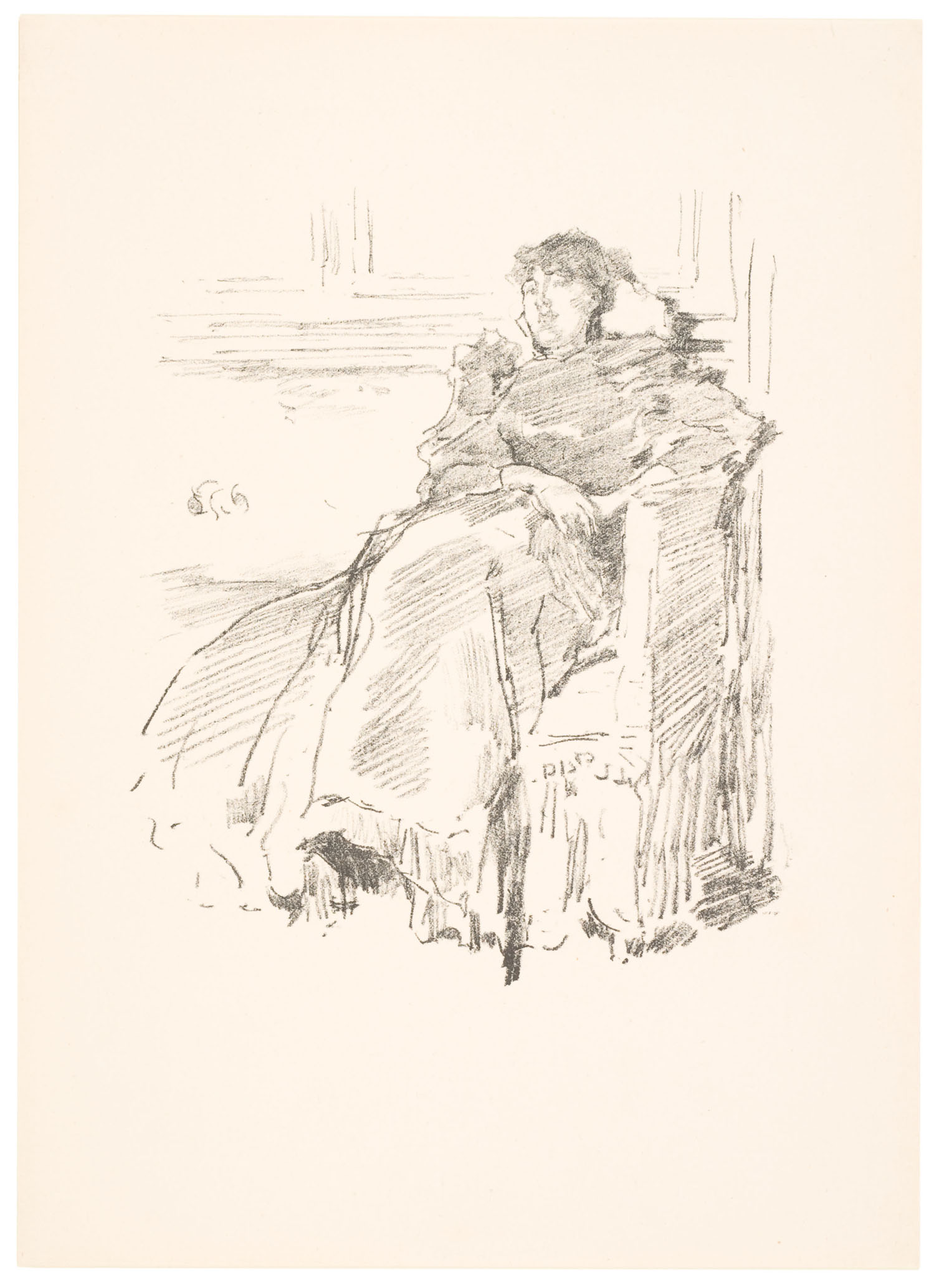
James McNeill Whistler (American, 1834–1903), La Robe Rouge, 1894, lithograph, Gift of Allen C. Poole, 1930.197
Description
Hi, I’m Melanie Stutenroth, associate director of philanthropy at the Cincinnati Art Museum. I am sharing the description of La Robe Rouge by James McNeill Whistler in George Bellows: American Life in Print.
La Robe Rouge, from 1894, is a lithograph by the American artist James McNeill Whistler, who lived from 1834 to 1903. It is a gift from Allen C. Poole, and the accession number is 1930.197.
James McNeil Whistler’s La Robe Rouge is a black and white vertically oriented lithograph measuring 23 by 17 inches or 58.42 by 43.18 centimeters. In this work, a middle-aged, dark-haired white woman wearing a high-necked, full-length gown with long puffed sleeves reclines at one end of a sofa. Her right arm is draped across her lap while her left elbow rests on the sofa’s arm. She clasps her hand at her waist. She stretches her legs out in front of her and crosses her ankles. Leaning back against the couch and the wood paneling behind her, she appears restful. The artist uses various shading intensities to denote her dark hair, lighter dress, and shadows behind and at the base of the couch.
Label
Hi, I’m Melanie Stutenroth, associate director of philanthropy at the Cincinnati Art Museum. I am sharing the label for La Robe Rouge by James McNeill Whistler in George Bellows: American Life in Print.
La Robe Rouge, from 1894, is a lithograph by the American artist James McNeill Whistler, who lived from 1834 to 1903. It is a gift from Allen C. Poole, and the accession number is 1930.197.
The American expatriate James McNeill Whistler took to lithography in 1878, when artists in France and England turned to the medium as a creative opportunity. He produced 179 prints over the next two decades. The artist favored using transfer paper, allowing him to draw directly at a site without needing to lug a heavy limestone block. La Robe Rouge, done in 1894, shows Beatrix Whistler reclining on a sofa against a paneled wall at 110 rue du Bac. Drawn with lithographic crayon on rough transfer paper, the texture becomes part of the image. In the first two decades of the twentieth century, Whistler exhibited etchings and lithographs in multiple venues in New York City along with other French practitioners at a time when American artists had yet to take up lithography as an artistic medium.
Cupid and Satyr
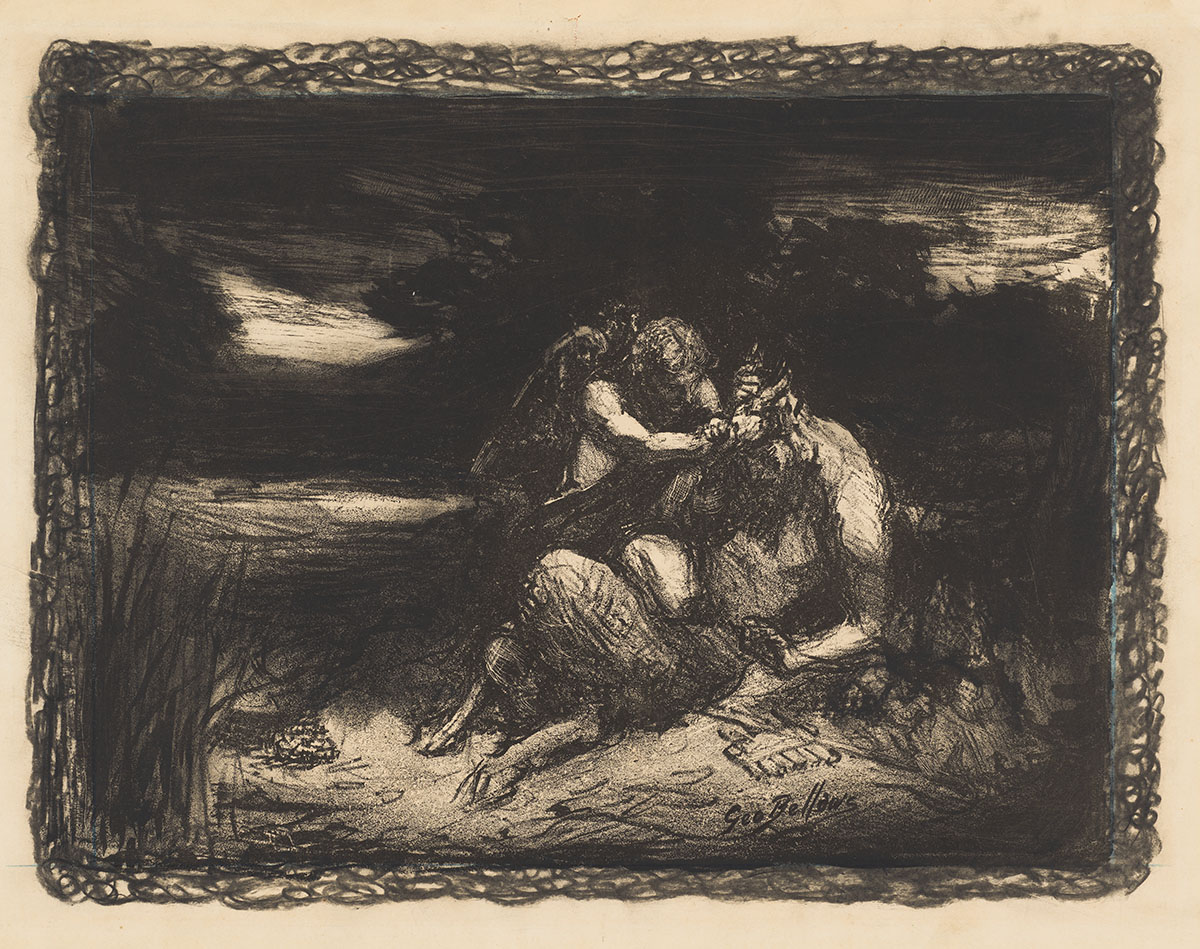
George Bellows (American, 1882-1925), Cupid and Satyr, 1915–16, lithograph with scraping, reworked with crayon, black ink, and blue pencil, The James and Lois Sanitato George W. Bellows Collection, 2018.270
Hi, I’m Alex Otte Callon, the museum’s manager of the Rosenthal Education Center. I am sharing the description of Cupid and Satyr in George Bellows: American Life in Print.
George Bellows, an American artist with life dates from 1882 to 1925, created Cupid and Satyr from 1915 to 1916. This print is a lithograph with scraping, reworked with crayon, black ink, and blue pencil. It is in The James and Lois Sanitato George W. Bellows Collection, and the accession number is 2018.270.
Cupid and Satyr is a horizontally oriented black and sepia lithograph with scraping that has been reworked with crayon, black ink, and blue pencil. This small image measures nine and seven-sixteenths by 12 and three-sixteenths inches or 23.9 by 31 centimeters on a sheet measuring 11 and three-sixteenths by 14 and five-sixteenths inches or 28.4 x 36.3 centimeters. Here, framed by a border of scribbly curving lines, is a dark outdoor scene of a cupid in the guise of a young man, wrestling a satyr, a creature that is half man, half goat. The satyr lies in a prone position on his back, propped up on his elbows. The cupid grasps the fallen satyr by his horns while the latter raises a hand to fend him off. A set of pan pipes lies in front of this scene.
Hi, I’m Alex Otte Callon, the museum’s manager of the Rosenthal Education Center. I am sharing the label for Cupid and Satyr in George Bellows: American Life in Print.
George Bellows, an American artist with life dates from 1882 to 1925, created Cupid and Satyr from 1915 to 1916. This print is a lithograph with scraping, reworked with crayon, black ink, and blue pencil. It is in The James and Lois Sanitato George W. Bellows Collection, and the accession number is 2018.270.
Growing up, Bellows's schooling fostered his interest in Greek and Roman history and mythology. A winged Cupid, the messenger of love, appears to be consoling a satyr, a half-human and half-beast, by grasping the horns of his downturned head. The subject may allude to omnia vincit amor, “Love conquers all,” from Virgil’s Eclogue 10.
Bellows signed this previously unrecorded lithograph on the stone in the lower right under the panpipes. Albert Sterner, a well-known lithograph artist, introduced Bellows to lithography in the winter of 1915–16. Financially successful, the artist set up a lithograph press in his home studio. Unsatisfied with this early experiment, Bellows reworked the right portion of the landscape and obliterated the blue pencil with crayon.
Sacred and Profane Love

George Bellows (American, 1882-1925), Sacred and Profane Love, circa 1906, black crayon, brush and wash, white gouache, The James and Lois Sanitato George W. Bellows Collection, 2023.84
Description
Hi, I’m Alex Otte Callon, the museum’s manager of the Rosenthal Education Center. I am sharing the description of Sacred and Profane Love in George Bellows: American Life in Print.
Sacred and Profane Love from around 1906 is black crayon, brush and wash, and white gouache. It was created by George Bellows, an American artist who lived from 1882 to 1925. It is in The James and Lois Sanitato George W. Bellows Collection, and the accession number is 2023.84.
Sacred and Profane Love is a vertically oriented drawing in black crayon, brush and wash, and white gouache. The image measures 11 by seven and three-sixteenths or 28 by 18.2 centimeters on a sheet measuring 14 and three-sixteenths by ten and three-eighths inches or 36 by 26.4 centimeters. In this work, a young white woman sits in a rounded-back wicker chair. She wears a high-neck button-down shirt with long puffed sleeves. Her skirt, with a dark belt, is A-line and reaches to the floor. Her hair is piled high on her head in a loose updo. She rests her chin on her right hand and looks contemplatively out at the viewer. Her left arm rests on the arm of her chair. An open discarded book lays on the floor to her right. Behind the woman, an angel dressed in a flowy toga-like gown hovers with arms open. Her right-hand rests on the woman’s shoulder. The artist has included a sizeable halo-like shape in the background, encompassing the angel and the woman. A small column with an iconic capital is just below that angel’s left hand.
Label
Hi, I’m Alex Otte Callon, the museum’s manager of the Rosenthal Education Center. I am sharing the label for Sacred and Profane Love in George Bellows: American Life in Print.
Sacred and Profane Love from around 1906 is black crayon, brush and wash, and white gouache. It was created by George Bellows, an American artist who lived from 1882 to 1925. It is in The James and Lois Sanitato George W. Bellows Collection, and the accession number is 2023.84.
Between September 1901 and the spring of 1904, Bellows attended Ohio State University and took all the art classes offered. His illustrations at the time were in the style of Charles Dana Gibson’s Edwardian feminine ideal, the Gibson Girl. Cecile Mear, the Cincinnati Art Museum’s conservator of works on paper, discovered this drawing when she separated the unstable backing from Cupid and Satyr. The backing sheet’s erased inscription has the easily identified words “Profane Love.” The inscription begins with an “S,” suggesting it reads “Sacred and Profane Love.”
Bellows opted not to take exams in 1904; instead, he headed for New York City and enrolled at the New York School of Art to further his artistic education. There, he fell under the influence of the charismatic instructor Robert Henri (1865 –1929), who encouraged Bellows to open his eyes to the world around him. Fully conceived, this drawing is not linked to any known projects.
Hungry Dogs

George Bellows (American, 1882-1925), Hungry Dogs, No. 2, 1916, lithograph, The James and Lois Sanitato George W. Bellows Collection, 2018.246
Description
Hi, I’m Julie Jump, the museum’s senior accountant. I am sharing the description of Hungry Dogs in George Bellows: American Life in Print.
George Bellows, an American artist who lived from 1882 to 1925, created the lithograph Hungry Dogs, No. 2, in 1916. It is in The James and Lois Sanitato George W. Bellows Collection, and the accession number is 2018.246.
Hungry Dogs, No. 2 is a vertically oriented lithograph in tones of black. The image measures 13 and seven-sixteenths by nine and eleven-sixteenths inches or 34.2 by 24.6 centimeters on a sheet measuring 16 by 12 inches or 40.7 by 30.5 centimeters. In this scene, a group of five dogs in various guises—digging, chewing on a bone, challenging each other—scrounge for food in a ramshackle outdoor space that is an alley. A metal barrel, with trash spilling from it, encompasses the left foreground. Above it, a dark wooden shutter missing slats hangs off its hinges. In the background, one can barely make out a multi-story tenement building with fire escapes, iron railings, and front stoops. In the midground, a dog stands atop a white mound that could be snow.
Label
Hi, I’m Julie Jump, the museum’s senior accountant. I am sharing the label for Hungry Dogs in George Bellows: American Life in Print.
George Bellows, an American artist who lived from 1882 to 1925, created the lithograph Hungry Dogs, No. 2, in 1916. It is in The James and Lois Sanitato George W. Bellows Collection, and the accession number is 2018.246.
The first lithograph Bellows claims to have made is Hungry Dogs, based on a 1907 drawing, Dogs, Early Morning, now in the Boston Public Library collection. Two versions of the lithograph, both in reverse of the drawing, reveal his struggle to control the tones' consistency.
When Bellows arrived in New York City in 1904, it was packed with tenement buildings housing a soaring population of immigrants. In keeping with Robert Henri’s encouragement to look at the ugly truths of the world, Bellows became loosely associated with a group of artists known as “The Eight,” including John Sloan, George Luks, William Glackens, and Everett Shinn, who rejected American Impressionism, academic realism, and the conservative stance of the National Academy of Design. When shown in the Exhibition of Independent Artists in 1910, the drawing received notice in The Nation, “George Bellows, in fact, forces expression to the danger point.” Harper’s Weekly acquired rights to reproduce the drawing in 1913.
Splinter Beach
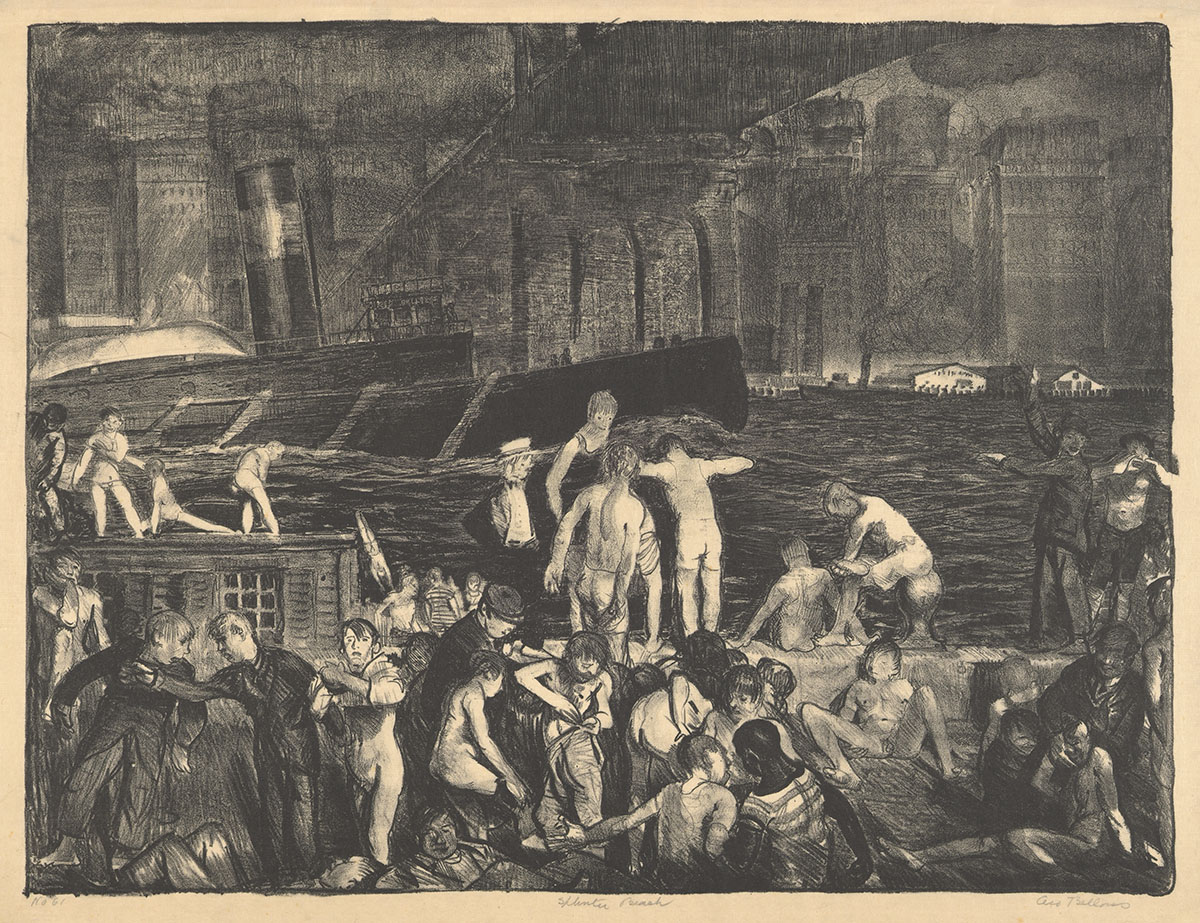
George Bellows (American, 1882-1925), Splinter Beach, 1916, lithograph and scraping, Private Collection
Description
Hi, I’m Julie Jump, the museum’s senior accountant. I am sharing the description of Splinter Beach in George Bellows: American Life in Print.
Splinter Beach from 1916 was created by George Bellows, an American artist who lived from 1882 to 1925. It is a lithograph with scraping. It is in a private collection.
The horizontally oriented lithograph, Splinter Beach, is a busy scene. The image measures 15 and one-sixteenth by 19 and thirteen-sixteenths inches or 38.3 by 50.3 centimeters on a sheet measuring 16 and one-eighth by 20 and seven-eighths inches or 40.9 by 52.9 centimeters. In this print, over two dozen people gather along New York City’s East River to bathe. Looming overhead and in the background, the Brooklyn Bridge stretches diagonally across the upper part of the work. The tall buildings in the city are also evident in the background. A large boat with a smokestack floats by in the midground. In the foreground, several men in various stages of undress lounge, bathe, talk, and rest along the river’s edge. In the lower-left corner, two men dressed in suits appear to be about to fight.
Label
Hi, I’m Julie Jump, the museum’s senior accountant. I am sharing the label for Splinter Beach in George Bellows: American Life in Print.
Splinter Beach from 1916 was created by George Bellows, an American artist who lived from 1882 to 1925. It is a lithograph with scraping. It is in a private collection.
Rather than the idylls of the American Impressionists, Robert Henri encouraged his students to open their eyes to the realities of urban life. For 18 years, the activities on the East River captured Bellows's attention, including tenement youth bathing under the Brooklyn Bridge. This location, with its strong vertical bridge piers and the passing boat, provided a backdrop for the interaction of the boys lounging and swimming. A sketch of one of the boys, one of many, appears on the verso of his lithograph Fantasy exhibited nearby. Bellows scratched his name on the pilot house of the passing tugboat. He would return to the subject, influenced by Jay Hambidge’s compositional theories of Dynamic Symmetry, in two paintings and a second lithograph circa 1923–24.
Artists Judging Works of Art
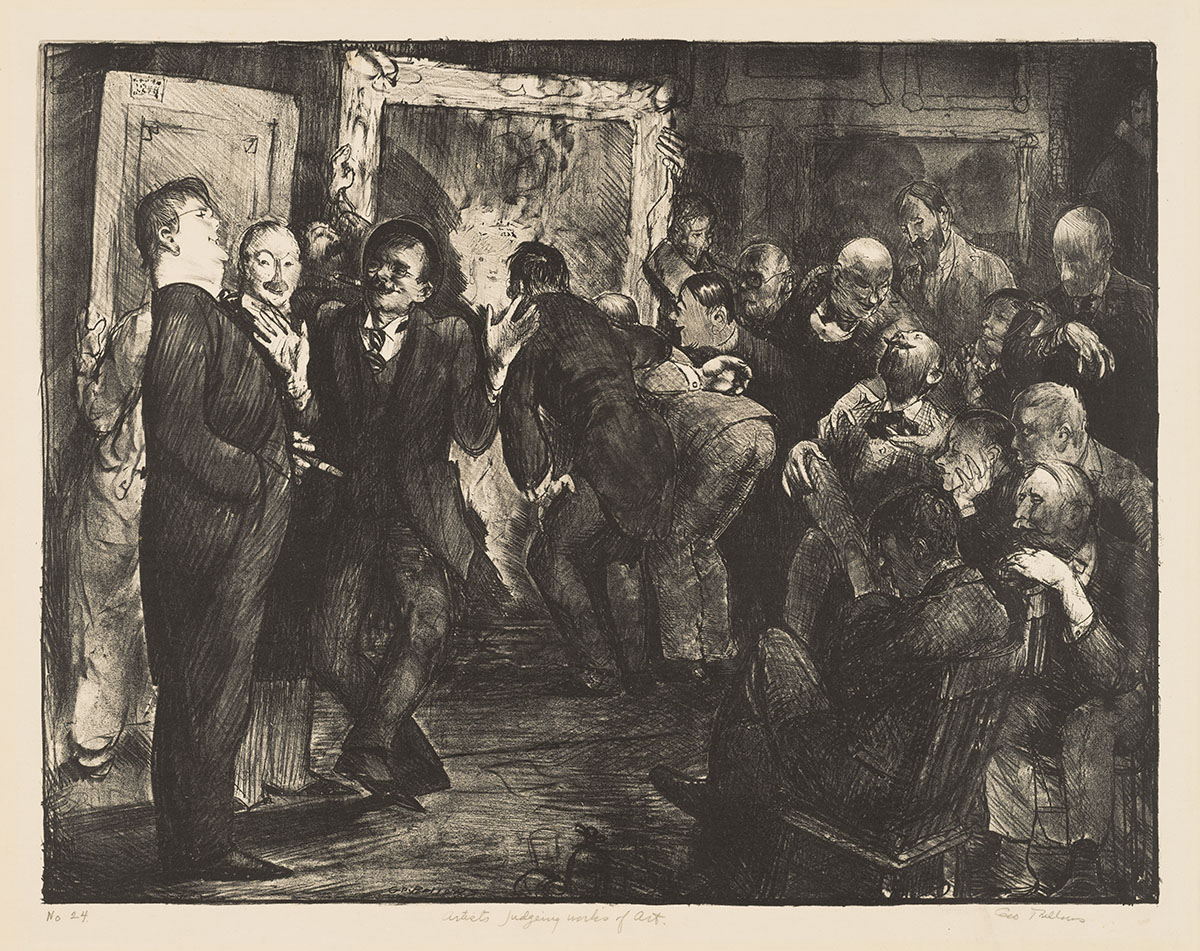
George Bellows (American, 1882-1925), Artists Judging Works of Art, 1916, lithograph working proof with additions in black crayon, The James and Lois Sanitato George W. Bellows Collection, 2018.247
Description
Hi, I’m Fiona Vieh, the museum’s gift shop manager. I am sharing the description of Artists Judging Works of Art in George Bellows: American Life in Print.
George Bellows, an American artist who lived from 1882 to 1925, created Artists Judging Works of Art in 1916. It is a lithograph working proof with additions in black crayons. It is in the James and Lois Sanitato George W. Bellows Collection, and the accession number is 2018.247.
Artists Judging Works of Art is a horizontally oriented lithograph working proof with additions in black crayon. The image measures 14 and thirteen-sixteenths by 19 and one-eighth inches or 37.6 by 48.5 centimeters on a sheet measuring 18 and thirteen-sixteenths by 22 and one-half inches or 47.8 by 57.2 centimeters. In this congested scene, a large group of middle-aged and older white men gather to view several substantial works of art evident in the background. Working from left to right, a group of three men speak animatedly. In the center, another group of three judges stoop to inspect a large painting of a woman. At the right, a large group of men sit and stand, chatting about the art on view. Along the bottom of the image, the words No. 24, Artists Judging Works of Art; Geo Bellows, are written in pencil.
Label
Hi, I’m Fiona Vieh, the museum’s gift shop manager. I am sharing the label for Artists Judging Works of Art in George Bellows: American Life in Print
George Bellows, an American artist who lived from 1882 to 1925, created Artists Judging Works of Art in 1916. It is a lithograph working proof with additions in black crayons. It is in the James and Lois Sanitato George W. Bellows Collection, and the accession number is 2018.247.
Robert Henri, an advocate for non-juried exhibitions, organized the first Exhibition of Independent Artists in 1910, in which Bellows participated. Throughout his career, Bellows straddled the line, participating in traditional juried exhibitions, yet advocating for independent non-juried shows. The Masses published Bellows drawing for the lithograph, Artists Judging Works of Art, in their April 1915 issue. The lithograph shows three figures examining the painting and intensifies the expressions and interaction of the all-male jury. This impression is a working proof before the final edition. In the center foreground, Bellows draws still life elements with black crayon and adds vertical shading to the back of the center most judge, whose hair, in the earliest impressions, is the white of the paper. He includes Robert Henri, seated in the shadows in the lower right, and a self-portrait as the bald figure with arms crossed observing the proceeding in the upper right.
In the Park

George Bellows (American, 1882-1925), In the Park, Dark, 1916, lithograph, Gift of Herbert Greer French, 1940.80
Description
Hi, I’m Fiona Vieh, the museum’s gift shop manager. I am sharing the description of In the Park, Dark in George Bellows: American Life in Print.
In the Park, Dark is a lithograph from 1916. The American artist George Bellows, who lived from 1882 to 1925, created it. It was a Gift of Herbert Greer French; the accession number is 1940.80.
In the Park, Dark is a horizontally oriented lithograph. The image measures 17 and one-eighth by 21 and seven-sixteenths inches or 43.5 by 54.4 centimeters on a sheet measuring 21 and seven-sixteenths by 27 and fifteen-sixteenths inches or 54.5 by 71 centimeters. In this work, the artist has captured a day at the park. The background is dark formed by the shadowed tree line. In the upper center, there is a break in the swath of dark in which a building is evident in the light. The middle ground is non-existent; only the stretching parkland is evident. In the foreground and stretching back into the midground, several groups of stylishly dressed women, children, and a few men rest, play, chat, and stroll through the park. A strong light source from the lower left corner illuminates their dresses and umbrellas.
Label
Hi, I’m Fiona Vieh, the museum’s gift shop manager. I am sharing the label for In the Park, Dark in George Bellows: American Life in Print.
In the Park, Dark is a lithograph from 1916. The American artist George Bellows, who lived from 1882 to 1925, created it. It was a Gift of Herbert Greer French; the accession number is 1940.80.
In February 1912, Bellows recorded an ink wash drawing, Luncheon in the Park, in his Record Book. The relaxation of middle-class women and their children captured his attention. He returned to the theme, and it became the subject of a painting, A Day in June, and two lithographs. In all these works, Bellows eliminates the middle ground, focusing on the foreground figures in white, strolling or reclining and silhouetted against a wooded landscape with a building visible in the upper center. The lithographs in reverse of the drawing reflect his preference for lithography with its flexibility to rework the stone and re-etch the altered image. In the Park, Dark is the first in the sequence with its background comparable to the painting. In In the Park, Light Bellows gave the building greater prominence, and the trees, individual definition. Exhibited together in 1919, they reflect the beauty of the design and a rich range of tones.
The Studio, Christmas 1916
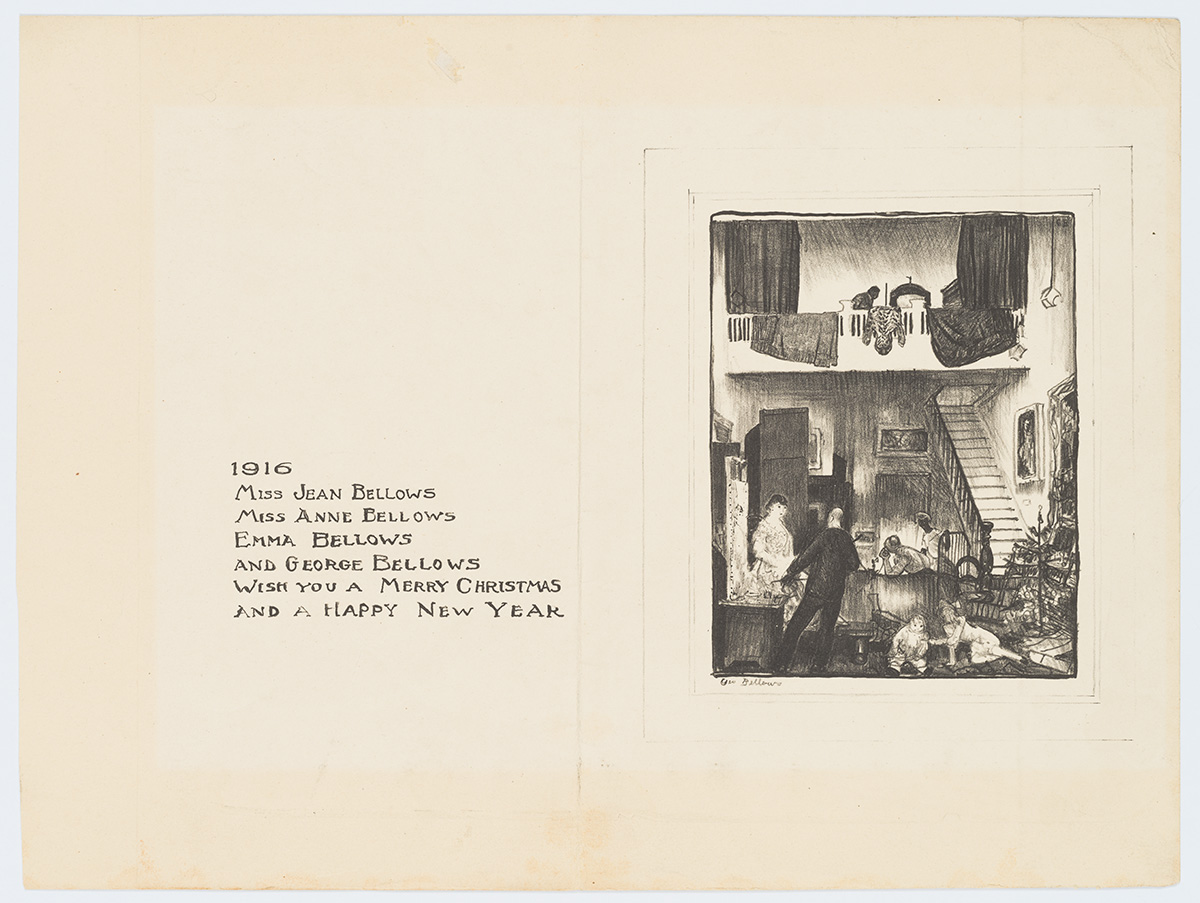
George Bellows (American, 1882-1925), The Studio, Christmas 1916, 1916, lithograph, Lent by Dr. James and Mrs. Lois Sanitato
Description
Hi, I’m Carrie Atkins Maras, the museum’s associate director of community engagement. I am sharing the description of The Studio, Christmas 1916, in George Bellows: American Life in Print.
George Bellows, an American artist who lived from 1882 to 1925, created the lithograph, The Studio, Christmas 1916 in 1916. It is on loan from Dr. James and Mrs. Lois Sanitato.
The Studio, Christmas, 1916, is a horizontally oriented black and white lithograph. The image measures five and seven-sixteenths by four and five-sixteenths inches or 13.8 by 10.9 centimeters on a sheet measuring ten and three-sixteenths by 13 and nine-sixteenths inches or 25.9 by 34.4 centimeters. This work was the family Christmas card, and in that form, the work has two parts. On the left read the inscription “1916, Miss Jean Bellows, Miss Anne Bellows, Emma Bellows and George Bellows Wish You A Merry Christmas and a Happy New Year.”
On the right side of this lithograph is a detailed image of the two-story interior of the Bellows’s home. On the first floor, George stands to the left, painting a portrait of his wife, Emma, while his daughters play on the floor in the center foreground. Several paintings and a Christmas tree on the right decorate the space. Emma’s mother is in the background, speaking on the phone. In the background on the right, a flight of stairs leads to the second floor and Bellows’s printing studio. His printer, George C. Miller, is shown working the press. Several large pieces of fabric hang over the railing, and drapery, used to close off the space, are evident on each side of the balcony space.
Label
Hi, I’m Carrie Atkins Maras, the museum’s associate director of community engagement. I am sharing the label for The Studio, Christmas 1916 in George Bellows: American Life in Print.
George Bellows, an American artist who lived from 1882 to 1925, created the lithograph, The Studio, Christmas 1916 in 1916. It is on loan from Dr. James and Mrs. Lois Sanitato.
Here, Bellows features his home at 146 East 19th Street, New York City, for the first of three family Christmas cards. When Emma Story accepted his proposal six years earlier, he acquired the three-story Federal-style house. Bellows remodeled the third floor as his studio having experience in construction as a youth working for his contractor father.
The Studio, Christmas 1916, shows him painting Emma while Jean, one, and Anne, five, play near the Christmas tree. Emma’s mother is in the background, speaking on the phone. Bellow’s printer, George C. Miller works on the press in the studio above. The inspiration may have been Diego Velázquez’s painting Las Meninas, which Bellows would have known from a reproduction, as he never traveled abroad. He includes his portrait, reflecting his artistic status and his role as a family man. This greeting card once belonged to Lewis Henry Meakin (1850–1917), honorary curator of painting at the Cincinnati Art Museum.
The Street

George Bellows (American, 1882-1925), The Street, 1917, lithograph, Lent by Dr. James and Mrs. Lois Sanitato
Description
Hi, I’m Carrie Atkins Maras, the museum’s associate director of community engagement. I am sharing the description of The Street in George Bellows: American Life in Print.
The Street is a lithograph created in 1917 by the American artist George Bellows, who lived from 1882 to 1925. It is on loan from Dr. James and Mrs. Lois Sanitato.
The Street is a heavily detailed vertically oriented lithograph. The image measures 19 by 15 and three-sixteenths inches or 48.2 by 38.6 centimeters on a sheet measuring 22 and five-sixteenths by 17 and one-quarter inches or 56.7 by 43.8 centimeters. This work shows life on a busy New York City street. In the background, a multi-storied, multi-windowed building dominates the scene. At the street level, shops and restaurants are evident. On the second and third floors, a man and two women sit and hang out of open windows and stand on a fire escape. In the upper left and stretching across the top of the print, the artist has included the bottom of an elevated train track and support beams. Also on the left is a set of stairs leading to the platform. In the middle ground and foreground, people jostle along the street. Those in the mid-ground are not overly well-detailed, but we can make out several men and women. In the foreground, just left of center, two well-dressed women walk arm in arm: the one on the left looks to her right, and the one on the right looks to her left at a commotion on the street. In the center, a group of children, their backs to the viewer, watch a woman scolding a barefoot older boy who looks frightened, her right arm outstretched, the other holding the boy by the shoulder. Behind them, a fruit and vegetable stand with shoppers crowded in front of it, taking in the scene with the woman completes the image.
Label
Hi, I’m Carrie Atkins Maras, the museum’s associate director of community engagement. I am sharing the label for The Street in George Bellows: American Life in Print.
The Street is a lithograph created in 1917 by the American artist George Bellows, who lived from 1882 to 1925. It is on loan from Dr. James and Mrs. Lois Sanitato.
Bellows successfully balanced storytelling with real-life observation as his teacher Robert Henri encouraged him. Growing up in a quiet residential Columbus, Ohio, neighborhood, urban life in the dense tenements of the Lower East Side struck Bellows. Harper’s Weekly paid Bellows a commission of $100 to illustrate Curt Hansen’s “Fixing the Responsibility,” published on April 11, 1914. His drawing “I was Beatin’ ‘is Face” follows the storyline of a police officer breaking up a brawl between a Roman Catholic boy and a Jewish boy that attracted a crowd. A second drawing, Pinched, transforms the subject by replacing the officer with a woman and moves two stylishly dressed women hidden by the officer’s arm to the foreground. Bellows adapted this drawing for the lithograph The Street, portraying two women striding arm-in-arm in the lower left and relegating the alteration to the background. All three versions occur in the tenement neighborhoods under the city’s elevated transport system.
1918–1919 The War Series
Description
Hi, I’m Zaq Andel, the museum’s associate director of donor programs and events. I am sharing the “1918 The War Series” section in George Bellows: American Life in Print.
The United States entered World War I in April 1917. Like many Americans, George Bellows opposed the war, but after America’s formal entry, he volunteered for the Tank Corps, although not called for service. The War Series of lithographs and paintings focuses on the atrocities committed by the Germans in Belgium. Bellows worked on the series for more than eight months between the spring and summer of 1918 with the assistance of the printer Edward Krause. While he knew nothing about combat and never visited the front overseas, he did portray with bold directness the viciousness of an invading army.
Bellows learned of the war crimes through documentary reports. In February 1918, Brad Whitlock’s series “Belgium: The Crowning Crime” appeared in Everybody’s Magazine and the abridged version of the Bryce Report derived from twelve hundred eyewitness accounts of the invasion of Belgium during August 1914, which appeared in the New York Times on May 13, 1915. He based seven lithographs on the Bryce Report, including The Germans Arrive, The Barricade, and Bacchanale. Beginning in July 1918, Bellows recreated his prints into monumental paintings. Three were exhibited in the 26th Annual Exhibition of American Art at the Cincinnati Art Museum.
Murder of Edith Cavell

George Bellows (American, 1882-1925), Murder of Edith Cavell from the War Series, 1918, lithograph, Lent by Dr. James and Mrs. Lois Sanitato
Description
Hi, I’m Zaq Andel, the museum’s associate director of donor programs and events. I am sharing the description of the Murder of Edith Cavell from the War Series in George Bellows: American Life in Print.
Murder of Edith Cavell from the War Series is a lithograph from 1918. It is by the American artist George Bellows, who lived from 1882 to 1925. It is on loan from Dr. James and Mrs. Lois Sanitato.
The lithograph Murder of Edith Cavell from the War Series is horizontally oriented and depicts a tragic scene from World War I. The image measures nineteen and one-sixteenth by 24 and eleven-sixteenths inches or 48.4 by 62.7 centimeters on a sheet measuring 25 by 31 and seven-eighths inches or 63.5 by 80.9 centimeters. In this print, the artist captures the interior of a two-story stone block prison. On the upper floor and to the left, four men stand along the railing in front of three jail cells. A stone staircase with a metal railing stretches from the middle center to the lower right. Midways along the stairs, a white woman in a light-colored dress stands, her right hand on the railing, the other resting on her upper chest. She turns to her right and looks at the activity in the lower left corner. At the bottom of the steps two guards wait for her descent. In the center foreground, three men sit propped against a wall, wounded or dead. Four guards stand in the lower left corner of the work, two with rifles, another standing on a step to adjust a lightbulb while the fourth looks on. Three small lanterns and a wall sconce strategically positioned illuminate the scene.
Hi, I’m Zaq Andel, the museum’s associate director of donor programs and events. I am sharing the label for Murder of Edith Cavell from the War Series in George Bellows: American Life in Print.
Murder of Edith Cavell from the War Series is a lithograph from 1918. It is by the American artist George Bellows, who lived from 1882 to 1925. It is on loan from Dr. James and Mrs. Lois Sanitato.
On August 4, 1914, Germany invaded Belgium. Upon United States entry into the war in 1917, Bellows focused on war subjects. The murder of Edith Louise Cavell (1865–1915) provided Bellows with a romantic heroine. A British nurse working in a Belgian hospital, she aided Allied soldiers’ escape. She was subsequently arrested for “war treason,” a crime punishable by death. On October 12,1915, she was executed by firing squad, prompting stories in the international press about her purity and Christian values.
Bellows’s lithograph dramatically stages Cavell’s journey and stop midway down a massive set of stone stairs. At the base, a prison guard directs her toward her executioners. Working proofs reveal Bellows reworked Cavell’s head. The lithograph illustrated the series “Belgium: The Crowning Crime,” by Brand Whitlock, U.S. Minister to Belgium, in Everybody’s Magazine in 1918. The Allied Salon along Fifth Avenue in New York City, and the May 1919 26th Annual Exhibition of American Art at the Cincinnati Art Museum included the painting created after the lithograph.
Hail to Peace, Christmas 1918

George Bellows (American, 1882-1925), Hail to Peace, Christmas 1918, 1918, lithograph, The James and Lois Sanitato George W. Bellows Collection, 2018.256
Description
Hi, I’m Zaq Andel, the museum’s associate director of donor programs and events. I am sharing the description of Hail to Peace, Christmas 1918 in George Bellows: American Life in Print.
George Bellows, an American artist who lived from 1882 to 1925, created the lithograph Hail to Peace, Christmas 1918, in 1918. It is in the James and Lois Sanitato George W. Bellows Collection, and the accession number is 2018.256.
Hail to Peace, Christmas 1918 is a small vertically oriented lithograph. The image measures four and one-half by three and three-quarter inches or 11.4 by 9.5 centimeters on a sheet measuring five and one-quarter by four inches or 13.2 by 10.2 centimeters. In this scene, a white woman in a full-length white nurse’s uniform is the focal point of the print. She looks up and to the right and raises her right arm, stretching out to the white dove in the upper left corner. Additional doves fly overhead in a darkened sky. To the nurse's right, another woman and a child, viewed from the back, also look at the illuminated dove. They stand on a pebbled surface where a dove sits; water and sailboats complete the scene behind them. Printed in the lower right corner is the artist's name, Geo. Bellows. He repeats his name in pencil just below the inscription and includes the letters “J.B.B.”
Hi, I’m Zaq Andel, the museum’s associate director of donor programs and events. I am sharing the label for Hail to Peace, Christmas 1918 in George Bellows: American Life in Print.
George Bellows, an American artist who lived from 1882 to 1925, created the lithograph Hail to Peace, Christmas 1918, in 1918. It is in the James and Lois Sanitato George W. Bellows Collection, and the accession number is 2018.256.
On November 11, 1918, the Allies and Germany signed an armistice to end hostilities on the Western Front of World War I. Shortly after that, the renowned dealer in Renaissance art, Joseph Duveen, approached Bellows on behalf of Helen Clay Frick to create two paintings, Dawn of Peace and Hail to Peace, in celebration of the end of the war. Hail to Peace became the third Bellows family Christmas card. Bellows pays tribute to the civilians of the American Red Cross, especially women, who unselfishly supported the war effort. The lithograph sends a message of thanksgiving for peace.
1920–1925
Hi, I’m Austin Lake, the museum’s event captain. I am sharing the “1919-1925” section in George Bellows: American Life in Print.
Only in 1920, after the end of World War I, did Bellows seriously return to lithography and to his successful collaboration with the expert printer Bolton Brown. In 1921, he created 60 lithographs, revisiting familiar themes like New York City scenes, fights, and satires. A new focus on portraiture at this time challenged his skills. In 1923, he completed commissions to illustrate two magazine serials: Donn Byrne’s The Wind Bloweth and H. G. Wells’ Men Like God. In 1923 and 1924, he translated many of his imaginative illustrations into lithographs. With new crayons designed for him by his printer, Bolton Brown, these lithographs, including Nude Study, Woman Kneeling on a Pillow, and a nostalgic childhood scene—Sixteen East Gay Street—take on a new refinement. He returned to an exciting boxing scene in Dempsey and Firpo, yet continued to create intimate portraits of his wife, daughters, and best friend, Eugene Speicher.
During his nine years as an artist lithographer, Bellows advocated for the fusion of subject, style, and medium, and for lithography as a fine art. In the 32nd Annual Exhibition of American Art, the Cincinnati Art Museum featured his lithographs. Bellows died of peritonitis on January 8, 1925. His mastery of the medium continues to resonate 100 years after his passing, having influenced generations of artists.
Counted Out, No. 1
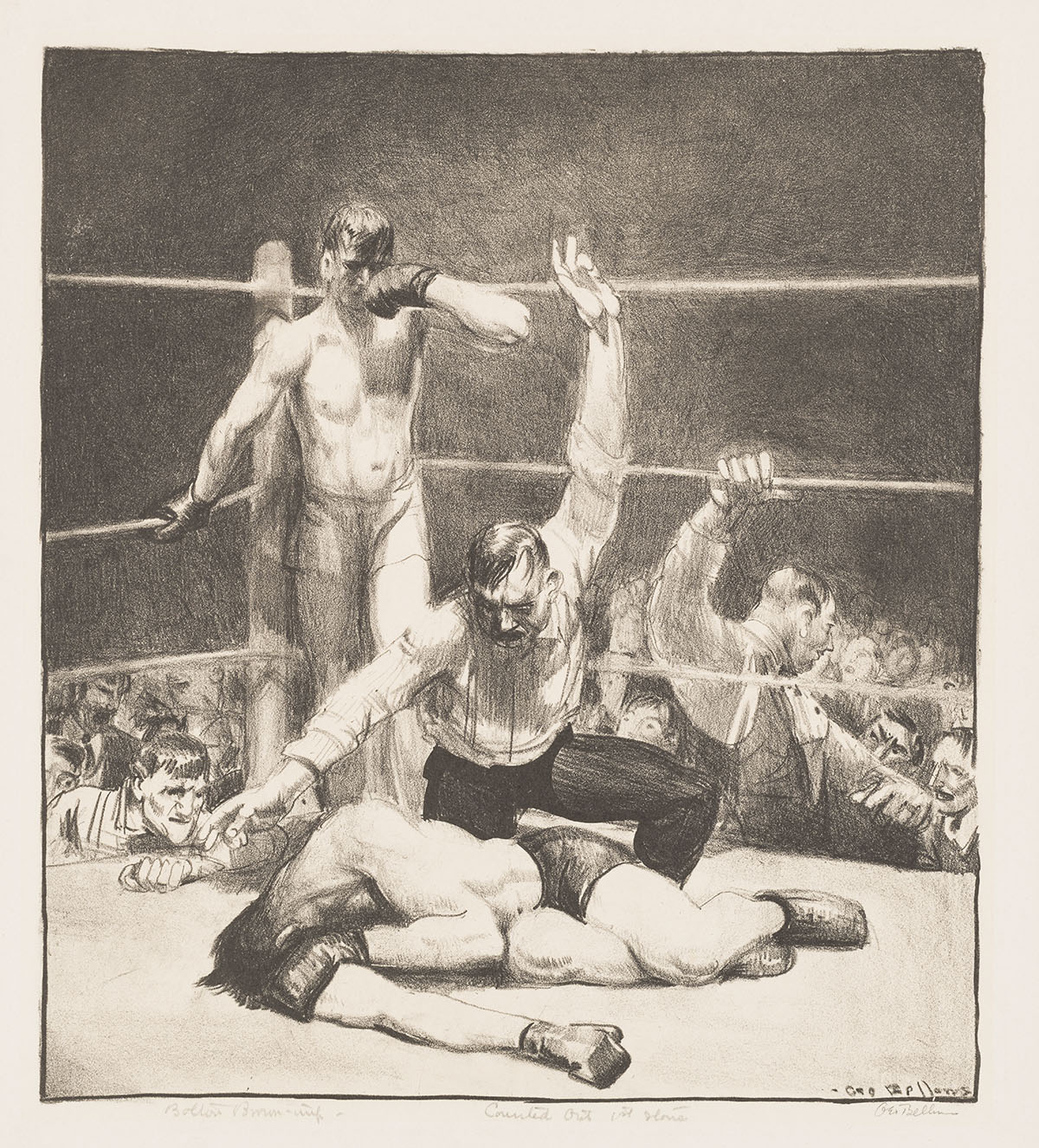
George Bellows (American, 1882-1925), Counted Out, No. 1, 1921, lithograph, Lent by Dr. James and Mrs. Lois Sanitato
Description
Hi, I’m Austin Lake, the museum’s event captain. I am sharing the description of Counted Out, No. 1 in George Bellows: American Life in Print.
Counted Out, No. 1 is a lithograph from 1921. The American artist George Bellows, who lived from 1882 to 1925, created it. It is on loan from Dr. James and Mrs. Lois Sanitato.
Counted Out, No. 1 is an almost square lithograph. The image measures 12 and one-half by 11 and one-eighth inches or 31.8 by 28.3 centimeters on a sheet measuring 15 and thirteen-sixteenths by 13 inches or 40.1 by 33 centimeters. Here, the artist captures the end of a boxing match. A referee squats on one knee in the center of the ring, extends his right arm out over the fallen boxer, and raises his left over his head. He holds up two fingers with his left hand. On the mat before the referee, a dark-haired white man wearing boxing trunks and shirtless lies on his side, his face buried in his shoulder. His left gloved hand rests on the upper part of his extended right arm. Behind the referee, another boxer, a white man wearing briefs and shirtless, stands in the corner of the ring, resting his gloved right hand on the ropes, his left held to his nose. On the other side of the ropes in the lower left, a white man with dark hair and a furrowed brow rests his elbow on the mat. To the right, a large man in a vest and button-down shirt raises his right hand to hold onto the ropes; he turns to talk to the men behind him. A hint of a crowd is evident in the background.
Label
Hi, I’m Austin Lake, the museum’s event captain. I am sharing the label for Counted Out, No. 1 in George Bellows: American Life in Print.
Counted Out, No. 1 is a lithograph from 1921. The American artist George Bellows, who lived from 1882 to 1925, created it. It is on loan from Dr. James and Mrs. Lois Sanitato.
In Counted Out, No. 1, the referee’s left hand becomes the top of a triangle with his right arm extended to the downed boxer’s head. The extended arms of the fan, hanging on the rope, forms the opposite side of the triangle. The downward thrust of the standing fighter’s arm forms the final side. The ring’s ropes and the floor divide the scene into quarters. With this composition Bellows is actively utilizing Jay Hambidge’s compositional theories of Dynamic Symmetry.
According to the Marquess of Queensberry boxing rules of 1867, when a fighter is down, the referee sends the other fighter to a neutral corner and begins a ten-count. The referee's count is considered a knockout victory if the downed fighter does not get up within ten seconds. Counted Out, No. 1 is based on one of four illustrations commissioned by The American Magazine to illustrate L. C. Moise’s story “The Last Ounce,” published in April 1913.
Self-Portrait
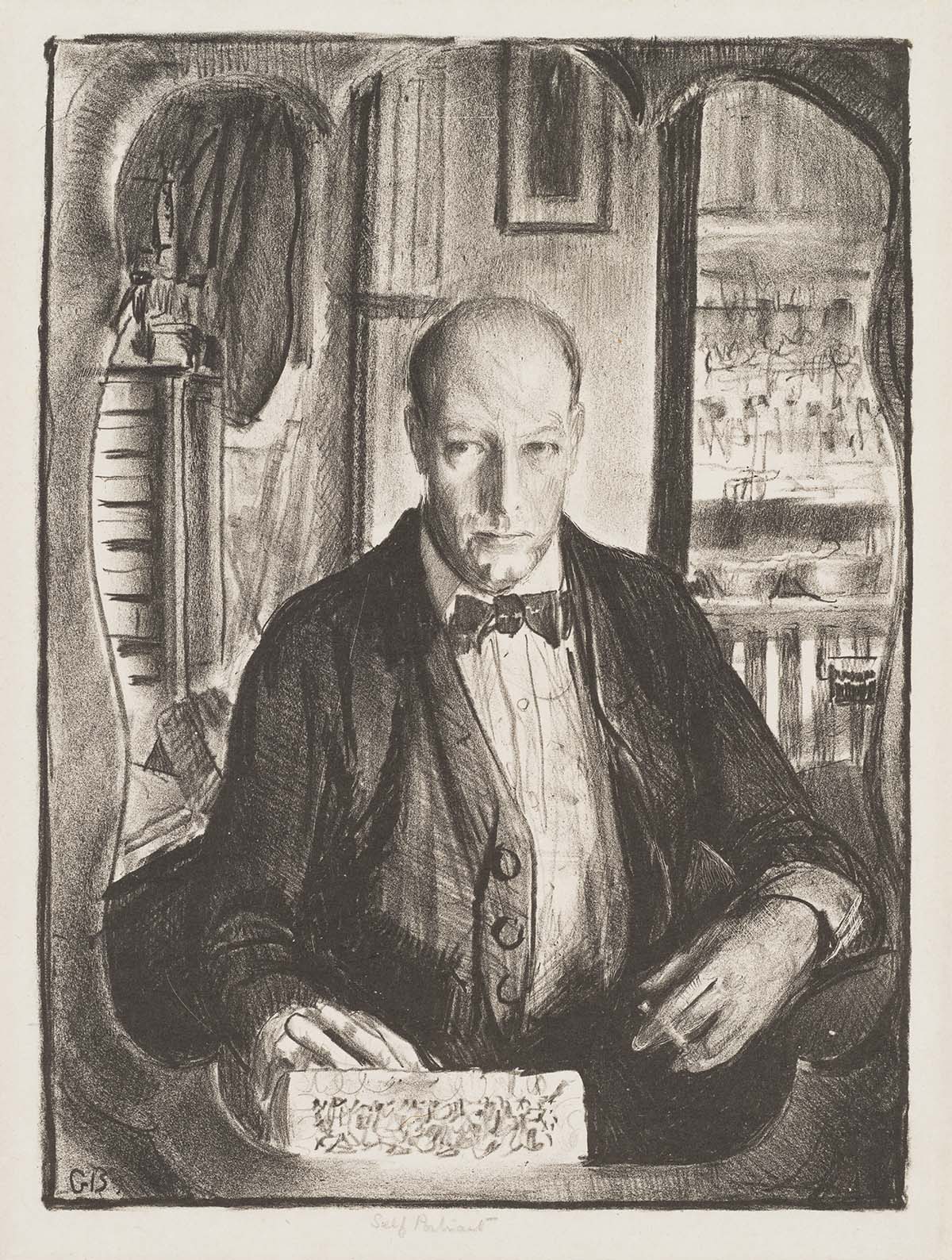
George Bellows (American, 1882-1925), Self-Portrait, 1921, lithograph, Lent by Dr. James and Mrs. Lois Sanitato
Description
Hi, I’m Elena Vincent, the museum’s curatorial administrative assistant. I am sharing the description of Self-Portrait in George Bellows: American Life in Print.
George Bellows, an American artist who lived from 1882 to 1925, created the lithograph, Self-Portrait in 1921. It is on loan from Dr. James and Mrs. Lois Sanitato.
Self-Portrait is a vertically oriented bust-length lithograph depicting the artist George Bellows at age 39. The image measures ten and nine-sixteenths by seven and thirteen-sixteenths inches or 26.8 by 19.8 centimeters on a sheet measuring 11 and eleven-sixteenths by nine and one-sixteenth inches or 29.7 by 23 centimeters. In this print, the artist captures himself looking in a vertical mirror with curved edges around the glass, creating scallop shapes. He has a long face with a narrow nose, a straight closed mouth, and a dimple in his chin. He does not look directly at the viewer but off to the left. He is almost bald with what looks like just a fringe of dark hair. Bellows wears a dark open jacket, white shirt, and bowtie. In his left hand, he holds either a cigarette or a lithographic crayon, and his right hand rests on a printing block. In the space behind him, we see his studio—to his right is a storage space holding art equipment and to his left is a wall, balcony, and a far wall beyond. The artist inscribed his initials “GB” in the lower left corner, and the words “Self-Portrait” are written in pencil at the page's bottom center.
Label
Hi, I’m Elena Vincent, the museum’s curatorial administrative assistant. I am sharing the label for Self-Portrait in George Bellows: American Life in Print.
George Bellows, an American artist who lived from 1882 to 1925, created the lithograph, Self-Portrait in 1921. It is on loan from Dr. James and Mrs. Lois Sanitato.
In the tradition of the old masters, Bellows contemplates himself at age 39 without artifice in this bust-length self-portrait, wearing a jacket and signature bow tie. His right hand on the lithograph stone conveys his confident mastery of this medium. His left hand holds a cigarette—or perhaps a crayon—ready to commit the next image to the limestone block. The Victorian mirror reflects his domain, the humble surroundings of his studio.
Four Friends
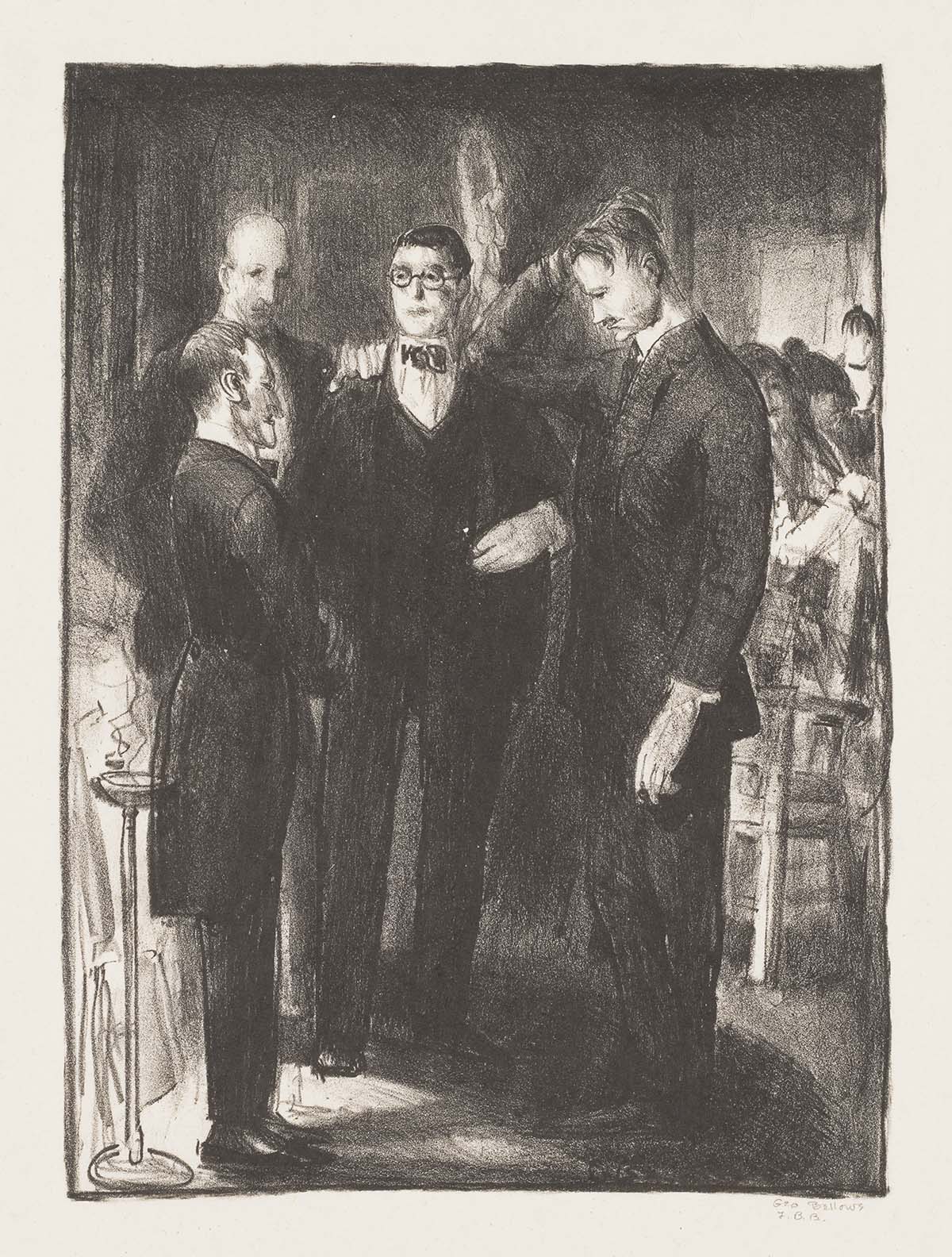
George Bellows (American, 1882-1925), Four Friends, 1921, lithograph, first state, Lent by Dr. James and Mrs. Lois Sanitato
Description
Hi, I’m Elena Vincent, the museum’s curatorial administrative assistant. I am sharing the description of Four Friends in George Bellows: American Life in Print.
Four Friends is a lithograph from 1921 created by the American artist George Bellows, who lived from 1882 to 1925. It is on loan from Dr. James and Mrs. Lois Sanitato.
The vertically oriented lithograph Four Friends captures the artists Leon Kroll, George Bellows, Eugene Speicher, and Robert Henri. The image measures ten and one-eighth by seven and three-eighths inches or 25.7 by 18.7 centimeters on a sheet measuring 12 and nine-sixteenths by nine and three-quarter inches or 31.9 by 24.8 centimeters. In this image, four middle-aged white men, all wearing dark three-piece suits and ties, stand in a group deep in discussion. The man on the left, artist Leon Kroll, faces the group, so we only see him in profile. Behind him is an ashtray on a waist-high stand. He has a long face with a pointed chin and receding dark hair. He is noticeably shorter than the other men. The artist George Bellows is to his left, visible just over Kroll’s head. He has an oval face and an almost bald head. His left hand rests on the right shoulder of the man at the center, Eugene Speicher. A tall man, Speicher, stands with a definite presence, his right hand in his pocket and his left resting at his hip. He wears small round glasses, and his dark hair is parted on the side and combed across his forehead. The final gentleman of this quad is Robert Henri, standing to Speicher’s left. Henri looks down, his gaze on Kroll across from him. He raises his right hand to his head, and his elbow appears to rest on Speicher’s shoulder. The artists’ wives sit in the background.
Label
Hi, I’m Elena Vincent, the museum’s curatorial administrative assistant. I am sharing the label for Four Friends in George Bellows: American Life in Print.
Four Friends is a lithograph from 1921 created by the American artist George Bellows, who lived from 1882 to 1925. It is on loan from Dr. James and Mrs. Lois Sanitato.
Four Friends is a mild satire memorializing Bellows's longstanding friendship with three friends who shared his passion for art. The short man with the hawk-like nose and arms crossed is Leon Kroll (1884–1974), who Bellows met the day he married Emma Story in 1910. An argument about impressionist use of pure color versus mixing color with black began at the reception and continued into the night. Eugene Speicher (1883–1962) stands at the center, intent on the conversation. His relationship with Bellows dates to 1907, when they met at a YMCA basketball game. At right is Robert Henri, Bellows’s mentor and friend. Bellows stands in the left background, listening. In the distant right background are their three wives.
My Family, No. 1

George Bellows (American, 1882-1925), My Family, No. 1, 1921, lithograph and scraping, The James and Lois Sanitato George W. Bellows Collection, 2018.259
Description
Hi, I’m Emily Hampel, the museum’s assistant to the director. I am sharing the description of My Family, No. 1 in George Bellows: American Life in Print.
George Bellows, an American artist who lived from 1882 to 1925, created My Family, No. 1 in 1921. It is a lithograph and scraping. It is in the James and Lois Sanitato George W. Bellows Collection, and the accession number is 2018.259.
My Family, No. 1 is a vertically oriented lithograph of the Bellows family. The image measures ten and one-sixteenth by seven and three-sixteenths inches or 25.5 by 18.3 centimeters on a sheet measuring 11 by nine and three-sixteenths inches or 28 by 23.4 centimeters. Here, the family arranges themselves around the central figure of the mother, Emma. She sits on a curved back couch. Emma wears a long, light-colored dress with a dark shawl over her shoulder. Her dark hair is in a bun at the back of her head. She is looking down and right at her elder daughter, Anne. Sitting in a small rocking chair, Anne looks down and away from her family. Aged ten, she wears her hair down, the top pulled back into a ribbon, and bangs cover her forehead. She wears a white dress that reaches just below her knees and simple black flats with an ankle strap. Her younger sister, Jean, age six, sits on the floor to the left of Emma. She has a similar hairstyle and dress to her older sister. She leans back against the couch, her left leg straight before her and her right bent up at the knee. Her left hand rests on the floor, and her right elbow is on her upraised knee. Her discarded doll sits in the lower right corner of the print. Gazing down on his wife and daughters, George stands behind the couch and to Emma’s right. He stretches his left arm along the sofa’s back, and his right bends before him. He is wearing a dark suit and his signature bow tie.
Label
Hi, I’m Emily Hampel, the museum’s assistant to the director. I am sharing the label for My Family, No. 1 in George Bellows: American Life in Print.
George Bellows, an American artist who lived from 1882 to 1925, created My Family, No. 1 in 1921. It is a lithograph and scraping. It is in the James and Lois Sanitato George W. Bellows Collection, and the accession number is 2018.259.
Between January and March 1921, Bellows created two versions of this lithograph: My Family, No. 1 and My Family, No. 2. In his Record Book, he refers to them as “My Family I (course)” and “My Family II (fine).” Around this time Bellows was exploring Jay Hambidge’s compositional theories of Dynamic Symmetry. “Hambidge has shown me a great many things that are profoundly true…even if it were not absolutely correct, it is anyhow useful to me.”
In My Family, No. 1, Bellows places his left arm on the couch, proclaiming himself a proud protector and father. The gesture intimately encircles his wife and daughters, arranged in a triangular configuration. In My Family, No. 2, Bellows shows his arms crossed and draws the figures of Emma and the children in a formal way. Their interrelationships are subtly adjusted to solidify the image into a formal family portrait.
My Mother
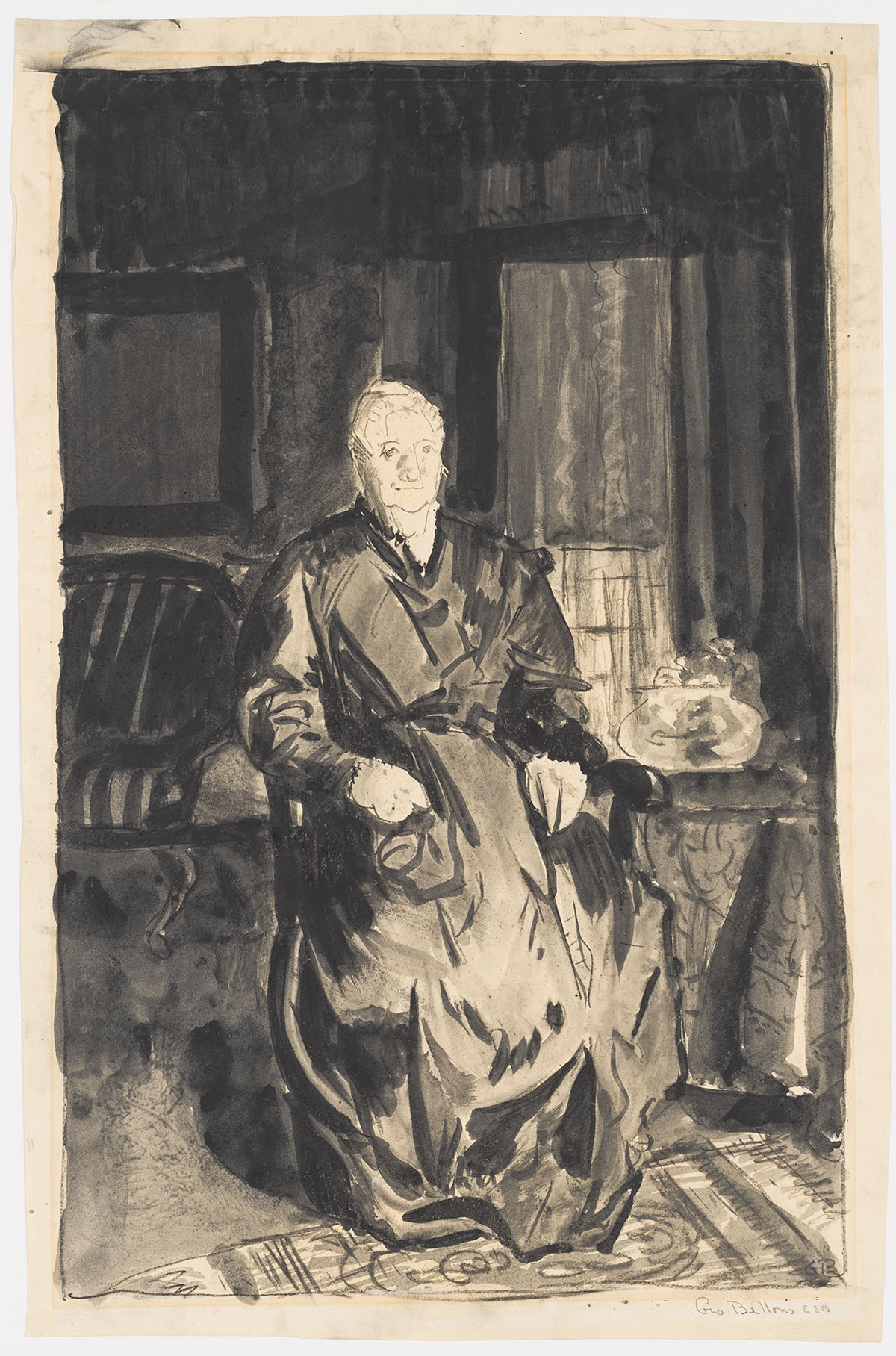
George Bellows (American, 1882-1925), My Mother, circa 1921, brush and black gouache, black crayon, and fixative, Lent by Dr. James and Mrs. Lois Sanitato
Study of My Mother
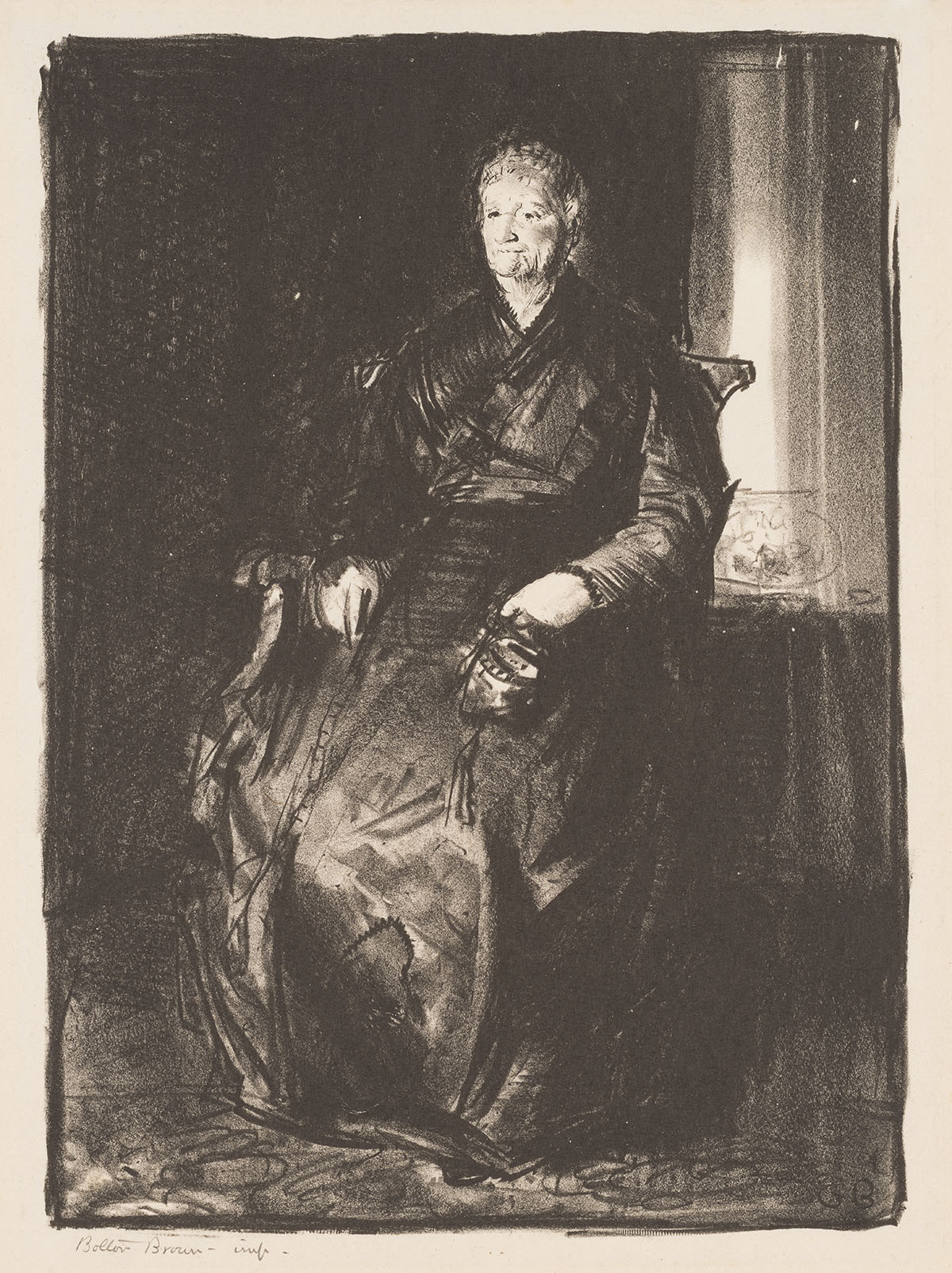
George Bellows (American, 1882-1925), Study of My Mother, No. 1, 1921, lithograph, Lent by Dr. James and Mrs. Lois Sanitato
Description
Hi, I’m Emily Hampel, the museum’s assistant to the director. I am sharing the descriptions of My Mother and Study of My Mother, No. 1 in George Bellows: American Life in Print.
My Mother and Study of My Mother No.1, from 1921, are by the American artist George Bellows, who lived from 1882 to 1925. My Mother is brush and black gouache, black crayon, and fixative; Study of My Mother, No. 1 is a lithograph. Both works are on loan from Dr. James and Mrs. Lois Sanitato.
The lithographs My Mother and Study of My Mother, No. 1 depict Bellows’s mother, Anna, and will be discussed together. Both works are vertically oriented and capture his elderly mother. The image My Mother measures 24 and one-sixteenth by 15 and seven-sixteenths inches or 61.1 by 39.2 centimeters on a sheet measuring 25 and three-eighths by 16 and thirteen-sixteenths inches or 64.5 by 42.7 centimeters. The image Study of My Mother No.1 is smaller, with the image measuring ten and one-sixteenth by seven and three-sixteenths inches or 25.5 by 18.3 centimeters on a sheet measuring 11 by nine and three-sixteenths inches or 28 by 23.4 centimeters. In both works, Anna sits in a chair, elbows resting on the arms and hands in her lap. The space where she sits is a bedroom or sitting room. Anna wears a full-length black dress with long sleeves, and her white hair is in a bun at the back of her head. She has a slight smile in both and looks directly at the viewer.
Between the two works, there are also differences to note. In My Mother, Anna’s surroundings are much more detailed. These include a patterned rug at her feet, and a table with a cloth to her left on which a teapot sits. Behind her is a window with a curtain and a sofa. She sits with her body turned to her left. Her dress is simplified, and her facial features are sketchy in appearance. In Study of My Mother, No. 1, Bellows has refined his composition. Anna sits facing to her right, and while the window and the table are still visible, they are simplified. In this work, Bellows has also further defined her facial features.
Label
Hi, I’m Emily Hampel, the museum’s assistant to the director. I am sharing the labels for My Mother and Study of My Mother, No. 1 in George Bellows: American Life in Print.
My Mother and Study of My Mother No.1, from 1921, are by the American artist George Bellows, who lived from 1882 to 1925. My Mother is brush and black gouache, black crayon, and fixative; Study of My Mother, No. 1 is a lithograph. Both works are on loan from Dr. James and Mrs. Lois Sanitato.
Label for My Mother
“Fair Anna,” as Bellows referred to his mother, was a tall, stout woman. My Mother is a study for a full-length portrait of Anna Bellows and relates to the earlier of two paintings at the Art Institute of Chicago created in March 1921. The folds of her dress and a related crayon sketch are followed in the painting. The background of this drawing lacks the coherent structure of the finished work. Here, Bellows places his mother in a historical Victorian setting. The fishbowl is set prominently to the right of Anna’s chair, while in the Chicago painting, it moves to the left background. The room's horizontal and vertical architectural elements, including the curtained and shuttered window at the right (providing an external light source), remain unresolved.
Label for Study of My Mother No.1
Two lithographs are associated with Bellows's paintings of his 83-year-old mother. While in reverse, Study of My Mother, No. 1 relates closely to the Art Institute of Chicago’s painting My Mother. At this point in his career Bellows had studied the old masters and was significantly impacted by the portraits in the memorial exhibition of the American realist painter Thomas Eakins (1844–1916) held at the Metropolitan Museum of Art in November 1917. In the lithograph, Bellows places his mother higher on the sheet, her regal monumental figure in black commanding attention and respect and, for those who knew her, deep affection. As in the Art Institute of Chicago painting, the fishbowl has been moved further into the background.
Billy Sunday
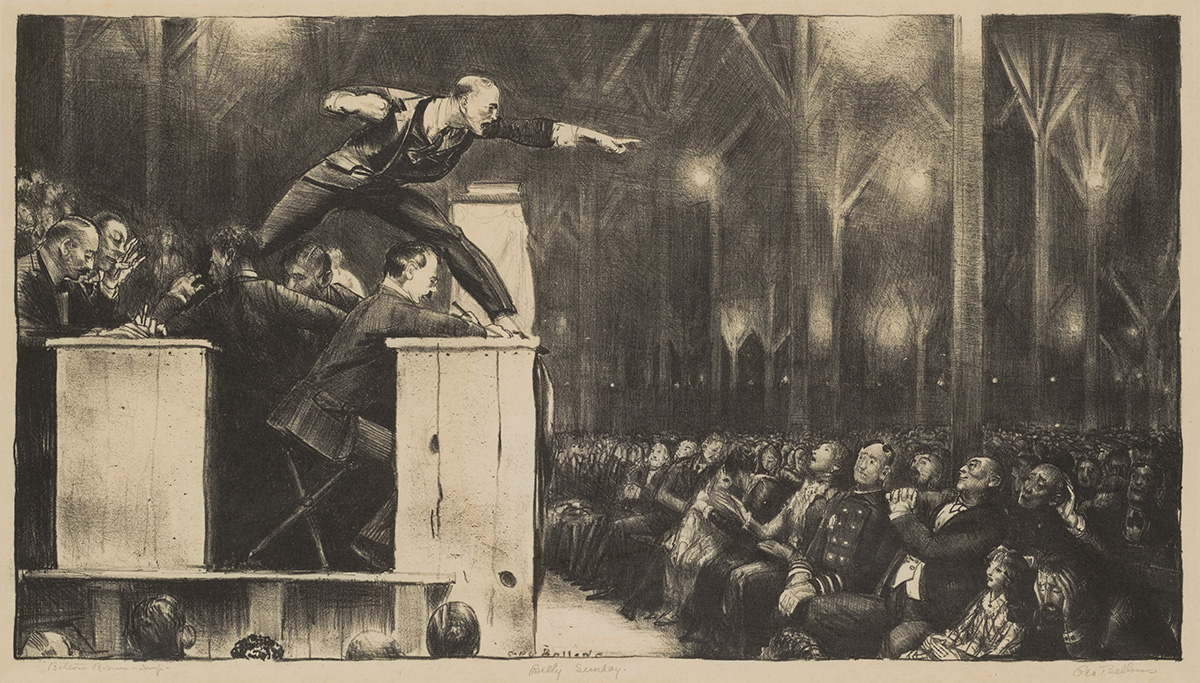
George Bellows (American, 1882-1925), Billy Sunday, 1923, lithograph, Lent by Dr. James and Mrs. Lois Sanitato
Description
Hi, I’m Marion Cosgrove Rauch, the museum’s assistant director of docent learning. I am sharing the description of Billy Sunday in George Bellows: American Life in Print.
American artist George Bellows, who lived from 1882 to 1925, created the lithograph Billy Sunday in 1923. It is on loan from Dr. James and Mrs. Lois Sanitato.
Billy Sunday is a horizontally oriented lithograph of the animated preacher of the same name. The image is eight and fifteen-sixteenths by 16 and three-sixteenths inches or 22.7 by 41.1 centimeters on a sheet measuring 15 and one-eighth by 21 and one-eighth inches or 38.4 by 55.6 centimeters. Here, the preacher, Billy Sunday, is captured from the side as he stands atop two raised parallel pulpit-like tables in a wide stance; his left leg is on the front table his right on the table behind. He bends at the waist, stretching his left arm out to the audience, pointing at his congregation. He pulls his right arm back as if he is about to throw a punch. An audience surrounds him—in front, in rows, behind, sitting at the raised tables, and to the side, heads just evident on the lower left of the print. Each has a different expression of awe and wonderment. The space is a large tabernacle with electric lights scattered throughout to illuminate the scene.
Label
Hi, I’m Marion Cosgrove Rauch, the museum’s assistant director of docent learning. I am sharing the label for Billy Sunday in George Bellows: American Life in Print.
American artist George Bellows, who lived from 1882 to 1925, created the lithograph Billy Sunday in 1923. It is on loan from Dr. James and Mrs. Lois Sanitato.
Billy Sunday satirizes the adoring rapture of the audience through facial expressions and gestures. In January 1915, Metropolitan Magazine commissioned Bellows to create illustrations to accompany the article “Back of Billy Sunday” by the radical journalist John Reed. Eight years later, Bellows takes the drawing and further exaggerates Sunday’s missionary zeal through gesture and his trademark stance. The audience has grown, with figures added in the foreground. Multiple lights have been added to the tabernacle, enhancing Sunday’s electrifying message: “Everything the devil’s in favor of I’m against…the rotten, licentious dances that have assassinated the characters of more girls than anything else in the world…It’s devil’s principal part to wreck women….”
Irish Fair
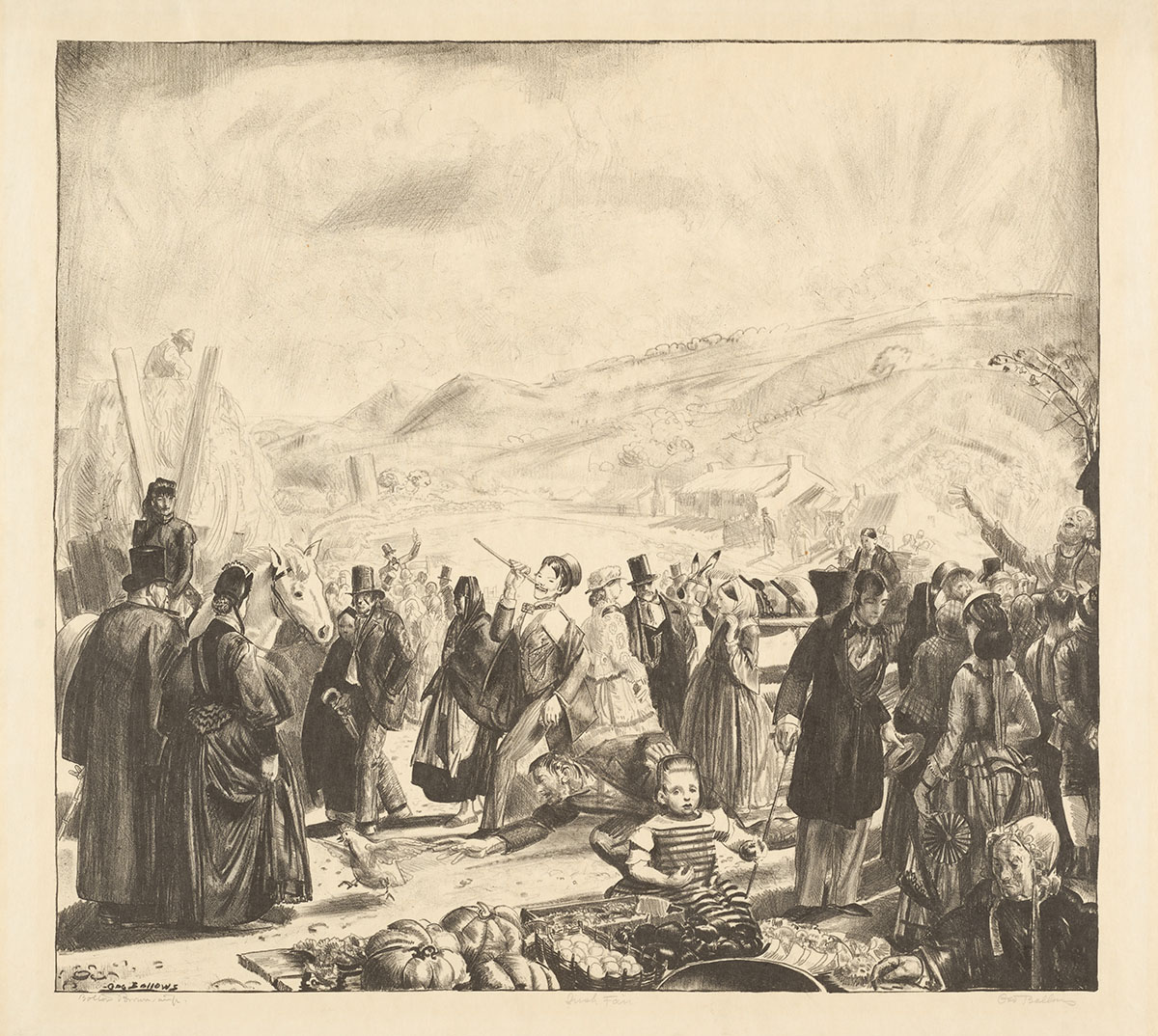
George Bellows (American, 1882-1925), Irish Fair, 1923, lithograph, The James and Lois Sanitato George W. Bellows Collection, 2018.263
Description
Hi, I’m Marion Cosgrove Rauch, the museum’s assistant director of docent learning. I am sharing the description of Irish Fair in George Bellows: American Life in Print.
The Irish Fair lithograph was created in 1923 by American artist George Bellows, who lived from 1882 to 1925. It is in the James and Lois Sanitato George W. Bellows Collection, and the accession number is 2018.263.
Irish Fair is a large, almost square, lithograph depicting an outdoor celebration. The image measures 18 and seven-eighths by 20 and three-quarters inches or 48 by 52.7 centimeters on a sheet measuring 22 and one-eighth by 26 and one-quarter inches or 56.1 by 66.6 centimeters. Here, Bellows captures a crowded country fair. In the background, rolling hills against a bright sky serve as a backdrop to the story unfolding in the foreground. Moving left to right on the page, the artist includes several stylishly dressed men and women walking through the fair and stopping to chat with passersby. In the center an animated young man dances and appears to play a flute. A table with pumpkins, eggs, and other foodstuffs is in the right foreground. A child in a striped outfit sits at the table and looks out at the viewer. Behind him, a man chases after a chicken. To the right of the table, additional men and women in frock coats and long dresses mill about.
Label
Hi, I’m Marion Cosgrove Rauch, the museum’s assistant director of docent learning. I am sharing the label for Irish Fair in George Bellows: American Life in Print.
The Irish Fair lithograph was created in 1923 by American artist George Bellows, who lived from 1882 to 1925. It is in the James and Lois Sanitato George W. Bellows Collection, and the accession number is 2018.263.
In 1922 Century Magazine commissioned Bellows to create 15 drawings to illustrate the romantic novel The Wind Bloweth by Irish author Donn Byrne. In the story, Shane Campbell, son of a Gaelic poet, sails the world in the last clipper ship in search of truth and life’s meaning. Bellows selected four of the illustrations to make as lithographs. The Irish Fair, portraying part six, “The Bold Fenian Men,” captures a small-town fair with “women in plaid shawls and frilled caps, men in somber black as befitted a monthly occasion,” and the confusion of squawking ducks, squealing pigs, and bawling auctioneers. The delicate background reflects Bellows’s collaboration with Bolton Brown, whose skill as a lithograph printer retained the subtle details of the landscape.
Dempsey and Firpo
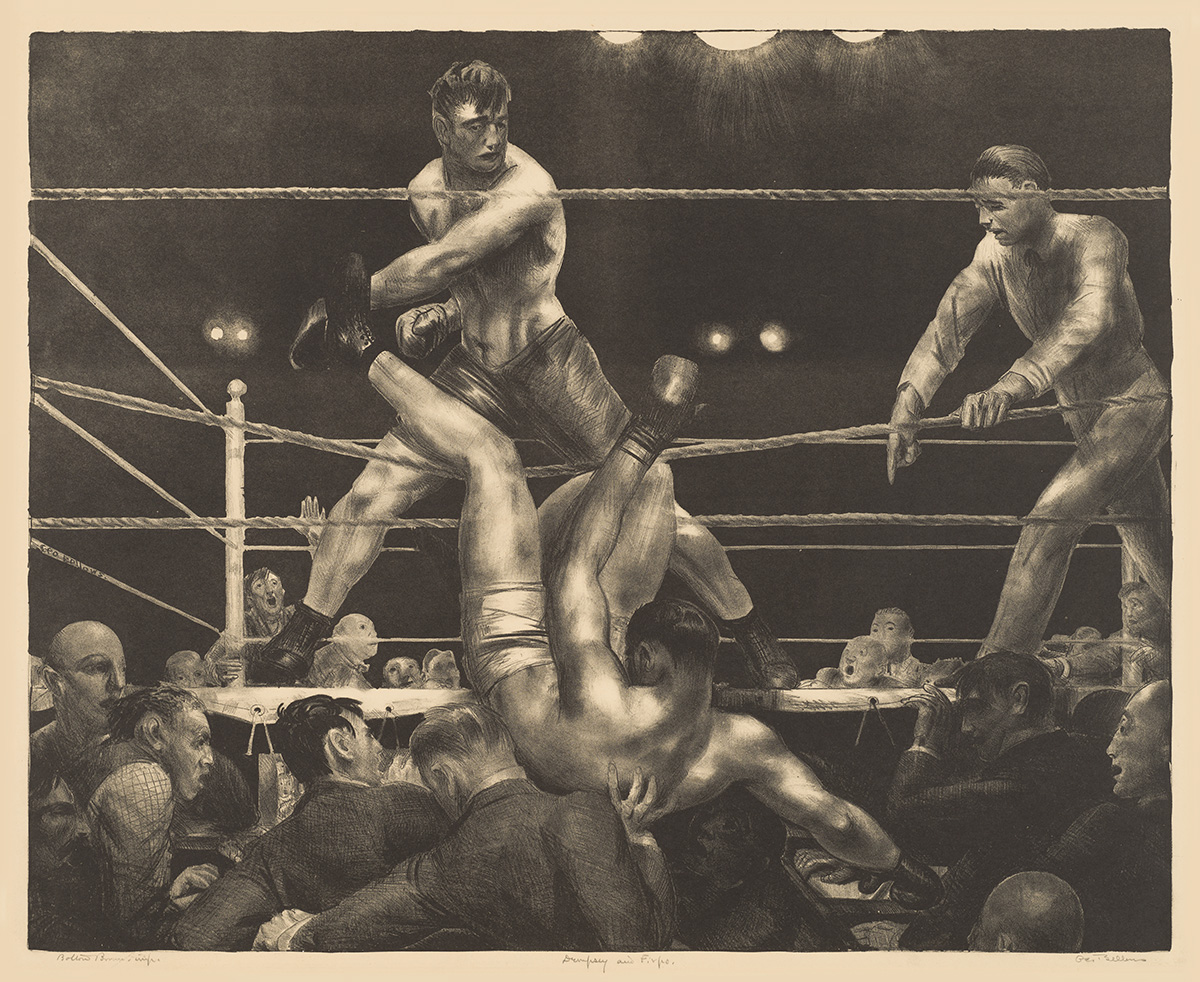
George Bellows (American, 1882-1925), Dempsey and Firpo, 1924, lithograph and rubbing, Gift of Albert P. Strietmann, 1953.243
Description
Hi, I’m Marion Cosgrove Rauch, the museum’s assistant director of docent learning. I am sharing the description of Dempsey and Firpo in George Bellows: American Life in Print.
Dempsey and Firpo, a lithograph and rubbing from 1924, is by the American artist George Bellows, who lived from 1882 to 1925. It was a Gift of Albert P. Strietmann, and the accession number is 1953.243.
Dempsy and Firpo is a horizontally oriented lithograph capturing the September 14, 1923, boxing match between Jack Dempsy and Luis Angel Firpo. The image measures 18 and one-sixteenth by 22 and three-eighths inches or 45.8 by 56.8 centimeters on a sheet measuring 22 and eleven-sixteenths by 26 inches or 57.7 by 66.2 centimeters. In this dynamic print, Bellows captures the moment when Dempsy knocks Firpo out, flipping him through the ropes and into the crowd below. Moving from the top of the image to the bottom, Dempsy, placed at the center inside the boxing ring, is shown in a dynamic pose of legs spread wide, right arm tucked into his side, and left arm dramatically swept across his body, having just punched his opponent. To his left, the referee pulls down the ropes surrounding the ring and points to the fallen Firpo. As we move down the print, the form of Firpo falling backward through the ropes is a focus. Having reached the crowd in his descent, he is shown feet in the air and torso supported by the raised hand of an audience member. The rest of the men in the foreground lean and step away from the falling form. In the background, behind Dempsy on the other side of the ring, several other spectators take in the scene.
Label
Hi, I’m Marion Cosgrove Rauch, the museum’s assistant director of docent learning. I am sharing the label for Dempsey and Firpo in George Bellows: American Life in Print.
Dempsey and Firpo, a lithograph and rubbing from 1924, is by the American artist George Bellows, who lived from 1882 to 1925. It was a Gift of Albert P. Strietmann, and the accession number is 1953.243.
“FIRPO FELLED TEN TIMES / Champion Downed Twice and Punched through Ropes at Outset.” — New York Times, September 15, 1923
Bellows’s boxing paintings and lithographs established his reputation early in his career. When he returned to the subject, the laws governing boxing in New York State had changed, making matches a public spectacle. The New York Evening Journal commissioned Bellows to illustrate the Dempsey and Firpo fight on September 14, 1923. Because of a printers’ strike, the illustration never appeared.
The artist’s preliminary figure drawings preceded this lithograph capturing the dramatic moment of the match between Jack Dempsey (1895–1983), the “Manassa Mauler,” and Luis Ángel Firpo (1894–1960), the “Wild Bull of the Pampas.”. The composition’s structural and volumetric elements use aspects of Dynamic Symmetry. His self-portrait as the bald man appears in the lower left corner. Bellows followed the lithograph with a painting created in June 1924, now in the Whitney Museum of American Art.
Bellows Chronology
Hi, I’m Emily Holtrop, the museum’s director of learning & interpretation. I am sharing the “Bellows Chronology” in George Bellows: American Life in Print.
1882: Born on August 12 at 265 East Rich Street, Columbus, Ohio, to Anna Smith Bellows and George Bellows, Sr.
1901–1904: Attends Ohio State University. Contributes cartoons for the Ohio State Journal and college publications.
Fall 1904: Leaves university at the end of junior year without taking exams. Moves to New York City and enrolls in New York School of Art where he studies with Robert Henri
Spring 1907: Exhibits River Rats at the National Academy of Design.
May 1908: Participates in the Cincinnati Art Museum’s Fifteenth Annual Exhibition of American Art. Exhibits every year except 1910 and 1911.
April 1909: Elected youngest Associate of the National Academy.
1910: Begins teaching Life and Composition classes at the Art Students League.
- April: Exhibits in the Exhibition of Independent Artists organized by Robert Henri.
- August: Buys house at 146 East 19th Street, New York City. Residence serves as studio.
- September 23: Marries Emma Louise Story.
1911: Continues teaching at Art Students League.
- January: Exhibits at the Madison Gallery, New York City, in his first one-person show.
- September: Daughter Anne is born.
- December: Joins Association of American Painters and Sculptors.
1912: Becomes a member of the planning and installation committee for the Armory Show.
1913, February-March: Exhibits five paintings and four drawings in the Armory Show. Studies European avant-garde art.
- May: Joins art staff of The Masses under John Sloan and contributes 25 illustrations from 1913 to 1917. Elected a full member of the National Academy.
1915: Installs a lithographic press in his studio. George C. Miller became his first printer
- February: Awarded Gold Medal at Panama-Pacific Exposition in San Francisco.
- April: Daughter Jean is born.
- November: Exhibits 25 paintings at the Cincinnati Art Museum in one-person show.
1916: Produces about 35 lithographs.
- April: Exhibits lithographs for the first time at Frederick Keppel & Company, New York City.
- Fall: Attends lectures by Jay Hambidge on compositional theories of Dynamic Symmetry.
1917: Produces 15 lithographs; paints very little.
1918, January-November:
- Cincinnati Art Museum exhibits three lithographs as part of the first traveling exhibition of the Painters-Gravers of America.
- Produces 17 lithographs and five paintings on German atrocities against Belgians during World War I.
- November 11: Armistice declared ending World War I.
1919, May: Five World War I paintings, including Murder of Edith Cavell, added to the Twenty-Sixth Annual Exhibition of American Art at the Cincinnati Art Museum.
1921, January–March: Produces 58 lithographs with new printer Bolton Brown
1923–24: Produces 64 lithographs; a number relate to commissions to illustrate for The Wind Bloweth and Men Like Gods.
1925: Dies on January 8 of peritonitis following surgery for a ruptured appendix.
- May: Cincinnati Art Museum features 36 lithographs in the Thirty-Second Annual Exhibition of American Art.
- October: Memorial Exhibition of the paintings and prints by George Bellows at the Metropolitan Museum of Art.
1966: Cincinnati Art Museum acquires oil painting titled Golf Course.






